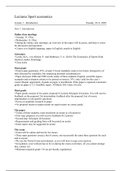Lectures Sport economics
Lecture 1 - Introduction Tuesday 10-11-2020
Part 1: Introduction
Online class meetings
• Tuesday 15-17hrs
• Wednesday 13-15hrs
• During the online class meetings, an overview of the topics will be given, and there is room
for discussion and questions
• Course is in English language, paper in English, emails in English
Literature
• Leeds, M.A., von Allmen, P. And Matheson, V.A. (2018) The Economics of Sports Sixth
Edition London: Routledge
• Class notes
Final grade
• Exam (open questions), 65%, at least 5.0 (not rounded), exam is two hours (irrespective of
time allocated by schedules, but respecting personal circumstances)
• Paper (between 3000 and 3500 words, teams of three students, English, scientific papers,
examples and evaluation criteria to be posted on nestor), 35%, only valid for this year’s
course! Repair opportunity if grade on paper is insufficient. If the paper is repaired, maximum
grade on paper is 5.5. Deadline repair: 30 March 2021 (date of resit).
Final grade
• Paper grade consists of two parts: proposal 0-2 points full paper 0-8 points. You will receive
feedback on the proposal. No intermediate feedback after the proposal, but of course
opportunities to ask specific questions.
• Focus on academic research in paper
• No proposal means no paper means no repair means no course grade.
The paper
• Teams of three students, team enrolment on nestor as of tomorrow
• First step: proposal, you will receive feedback (0-2 points)
• Second step: full paper (0-8 points)
• Requirements and grading form will be posted on nestor
• Some topics may be suggested on nestor
The exam
• Exam will be online and last for two hours.
• Three open questions (essay), but of course, not necessarily the same three question for each
and everyone.
• We use the Nestor Exam environment, so you will have to type your answers.
• Invigilation: your webcam has to be on during the exam at all times. (If you cannot arrange
this, contact us)
• Minimum required grade: 5.0 (as per faculty regulations)
,Schedule
• 10 nov: Introduction (RHK)
• 11 nov: Review of economic concepts (chapters 1, 2, ES)
• 17 nov: Sports Leagues and Franchises (chapter 3, RHK)
• 18 nov: Monopoly and Antitrust (chapter 4, RHK)
• 24 nov: Competitive Balance (chapter 5, RHK)
• 25 nov: Public Finance of Sports: Who Benefits and Who Pays (chapters 6,7, ES)
• 1 dec: Mega Events (chapter 8, ES), proposal due
• 2 dec: Labour Markets in Professional Sports (chapter 9, RHK)
• 8 dec: Labour Market Imperfections (chapter 10, ES), feedback on proposals
• 9 dec: Discrimination (chapter 11, RHK)
• 1 dec 2020: email proposal for paper (see example form on nestor), send email to
r.h.koning@rug.nl.
• Exam date: see roosters.rug.nl
• 15 jan 2021: hand in paper through website (deadline: 1.00pm), the paper will be scanned
for plagiarism
Part 2: Sports economics 1
Overview sports on television. Eredivisie, soccer matches.
2019: most viewed programmes. Sports isn’t in it. Sports has separate ranking.
This is the overview of the most viewed programmes with sports (nr.1 is not the
Luizenmoeder anymore).
,In 2018, the Luizenmoeder is again well watched. Year of the WK for soccer. In general if
you look at television, soccer is by far most popular sport. So sport is important, many people
watch it.
Satellite accounts 2015
› 1.0% of GDP, total value added b€6.2
› 2.9% of total consumption of households
› 130 thousand employed, 1.3% of all employed
› Mainly categories ‘other services’, ‘shops, restaurants, and repair’ that have typically low
productivity.
,Participation sport
› Sport consumption: € 473 (per household)
› Clothing: 15%
› Shoes: 12%
› Memberships: 53%
› Rental accommodations: 8%
Sport consumption. Most is spent on memberships. Fitness industry is big.
See that total spend increased. Expenditures on membership fees also increases with income.
Soccer economics 2018/2019
› Revenues M€ 451 (5851)
› Matchday: 18% (13%)
› Sponsorship: 38% (28%)
› Broadcast: 12% (59%)
› Other commercial 32% (-)
Soccer most professional sport in Europe.
Matchday -> tickets
Numbers in brackets is in the UK, so much higher.
What is sports economics
› A sport economist analyse sport as an economic activity, so as an activity that involves
choices and scarce means to reach certain aims.
› What is sport?
Difficult issue. Different elements come to mind. Depends a bit on how far you want to go
defining sport. Complicated discussion. More important distinction is do you want to
distinguish sport from physical activity or competition? Physical activity with element of
competition. Running in the morning is also considered as sport.
› Scarce means?
› Which aims, whose objectives?
, Professional sport aim is to win. Aim of Ajax or PSV is win title. Team of Emmen might
have different aim.
Academic origin
› Rottenberg (1956) ‘The Baseballs Players Market’
› Theorem of Coase (around 1961)
If property rights are allocated
Participants in negotiations choose most efficient alternative independently of
allocation of property rights.
› Reserve clause
Competitive balance
› A sporting contest has at least 2 opponents
› Louis-Schmeling paradox (Bud Selig)
Joe Louis was a boxer. He was a good one. He found out people were willing to pay more
if opponent was stronger. Equal opponents means that match lasts longer, they get hit
more. For financial aspects you want to get hit more. Duration of boxing depends on
quality differences between 2 boxers. Being hurt fills the purse. Professional sports get
more valuable improves quality of competition and increases financial aspect. Top
athletes need to sweat -> competition. More balanced is more interesting. Viewing figures
(seen before) depend on balanced matches.
European Ranking Table Tennis (female, fall 2017)
Many players and if you look at names you wouldn’t think they’re Dutch (or other
nationality). From China moved to NL. Chinese table tennis players were too many, so they
restricted the number of players -> more balanced. Top players still in China. More like
numbers 10-15 over here.





